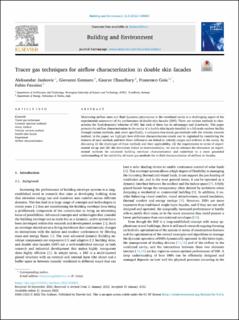| dc.contributor.author | Jankovic, Aleksandar | |
| dc.contributor.author | Gennaro, Giovanni | |
| dc.contributor.author | Chaudhary, Gaurav | |
| dc.contributor.author | Goia, Francesco | |
| dc.contributor.author | Favoino, Fabio | |
| dc.date.accessioned | 2022-02-10T13:34:53Z | |
| dc.date.available | 2022-02-10T13:34:53Z | |
| dc.date.created | 2022-02-07T19:19:33Z | |
| dc.date.issued | 2022 | |
| dc.identifier.issn | 0360-1323 | |
| dc.identifier.uri | https://hdl.handle.net/11250/2978277 | |
| dc.description.abstract | Monitoring airflow rates and fluid dynamics phenomena in the ventilated cavity is a challenging aspect of the experimental assessment of the performance of double-skin facades (DSF). There are various methods to characterize the fluid-dynamics behavior of DSF, but each of these has its advantages and drawbacks. This paper presents the airflow characterization in the cavity of a double-skin façade installed in a full-scale outdoor facility through various methods, and, more specifically, it compares two tracer gas methods with the velocity traverse method. In the paper, we highlight how different characterization results can be explained by considering the features of each method, and how these differences are linked to velocity ranges and airflows in the cavity. By discussing (i) the challenges of these methods and their applicability, (ii) the requirements in terms of experimental set-up and (iii) the limitations linked to instrumentation, we aim to enhance the discussion on experimental methods for advanced building envelope characterization and contribute to a more grounded understanding of the suitability of tracer gas methods for in-field characterization of airflows in facades. | en_US |
| dc.language.iso | eng | en_US |
| dc.publisher | Elsevier | en_US |
| dc.rights | Navngivelse 4.0 Internasjonal | * |
| dc.rights.uri | http://creativecommons.org/licenses/by/4.0/deed.no | * |
| dc.title | Tracer gas techniques for airflow characterization in double skin facades | en_US |
| dc.type | Peer reviewed | en_US |
| dc.type | Journal article | en_US |
| dc.description.version | publishedVersion | en_US |
| dc.source.volume | 212 | en_US |
| dc.source.journal | Building and Environment | en_US |
| dc.identifier.doi | 10.1016/j.buildenv.2022.108803 | |
| dc.identifier.cristin | 1998761 | |
| dc.relation.project | Norges forskningsråd: 262198 | en_US |
| dc.relation.project | EC/H2020/952886 | en_US |
| cristin.ispublished | true | |
| cristin.fulltext | original | |
| cristin.qualitycode | 2 | |

